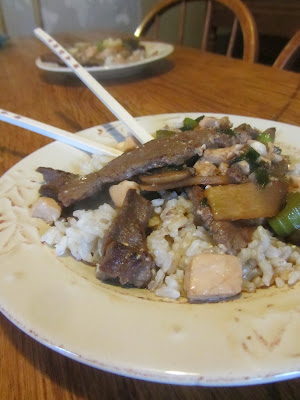Last month, I had the privilege of taking our Co-operative Geography Club on a "trip" to Japan. We had a wonderful trip and even "brought back" a few crafty souvenirs. Here's our travel log...
(This post contains affiliate links. Please see my disclosure policy for full details.)
As a brief living-literature introduction to Japan, we read Grandfather's Journey together. Then, the Littles (babies-5 year-olds) were dismissed to explore the book further in their book club as the geography club "unpacked our bags" to tour Japan.
Teaching Time
Geography
- Japan is called Nippon by its people. It means "land of the rising sun."
- It is made up of 4 large islands and over 4, 000 smaller ones.
- When combined, the land masses are smaller than the state of California.
- Tokyo is the capitol city and is the most populous city in the world.
- Japan is known for its earthquakes and typhoons.
- Mt. Fuji, the tallest mountain in Japan, is one of its many active volcanoes, but has not erupted since 1707.
Everyday life/culture
- Buddhism is the main religion of Japan.
- Historically, the people of Japan have worn Kimonos, long silk robes tied with silken sashes.
- Shoes are never worn inside a Japanese home.
- In Japan, people greet one another with a bow at the waist.
- Hello = "Ko-nee-tchi-wa", Goodbye = "sayonara"
- New Year's is the most important national holiday.
- Sumo wrestling is a popular national sport.
- There are over 1, 800 characters in the Japanese written language.
- Because of metropolitan congestion, most people travel to and from work by bullet train.
- In 1853, Commodore Matthew Perry of the US Navy brought Western influences to the nation.
Food
- Japanese eat at low tables and traditionally use chopsticks instead of silverware.
- Soup is slurped straight from the bowl.
- An empty plate shows that you'd like "seconds". Whereas, a plate with a small amount of food left shows that you are finished eating.
- Rice is served at every meal.
- Squid is the most popular pizza topping.
- It is good manners to eat small portions of each item on your plate, as opposed to completely finishing one dish before beginning another.
Inventions/Industry
- Common Japanese exports include rice, silk, electronics, and fish.
- Japan is credited with the development of the novel, futon mattress, VHS, DVD, and CD-Rom players, soy sauce, sushi, and Super Mario Brothers.
Snack
My sweet sister-in-law was kind enough to make us some cucumber/cream-cheese vegetarian sushi so that we could sample a little of the national cuisine.
It was the first time for ALL of the children to try this traditional Japanese dish. The group's response was quite mixed!
Cultural Sample
We watched a portion of a concert featuring the traditional Japanese instruments, shamisen (guitar-like), koto (harp-like), shakuhachi (large wooden flute).
We also watched two scenes from a Reading Rainbow episode. The first is of a koto (1:40) and the second is of a popular Japanese festival drum group (21:50).
Project Presentations
Origami fish
At the end of last year, Sweetie Pea had chosen origami as her last month-long independent project. So, it was only natural that she would want to demonstrate an easy origami creation to the club members. She passed out origami paper and led the kids in a step-by-step origami fish.
Directions to create an origami fish:
Begin with one piece of origami paper turned to the plain white side. Rotate the paper so that it looks like a diamond-shape. Fold the paper in half so that two vertexes (corners) meet. Crease to form a triangle. Fold the "long" side of the triangle "up" about 3/4 of an inch. Crease.
At this point, the paper should look like a boat. Fold "the boat" in half at the point of the "sail". Now, your paper will look like a smaller triangle with a flap sticking out of one side. Turn the triangle so that the "flap" points downward. The flap is actually made of two separate flaps. Fold the top "flap" up to form the tail of the fish.
Invert a small portion of the opposite end of the triangle to form a mouth. Using a pen, draw a small eye.
Faux Wood Block Print
Before leading the club members to create a faux wood block print, Super Boy, shared this very interesting video showing this historically, popular Japanese art form.Directions to create a faux wood block print:
Using a pen, "carve" a picture into a clean "block" of styrofoam. (I was able to get a handful of unused meat/veggie trays from the produce department of a local grocery store. Super Boy and I cut the lipped edges off of them leaving a flat piece of styrofoam block.)
Paint over the entire "block." Press a clean piece of paper onto the block being sure to smooth out all lumps and bubbles. In a swift, upward motion, remove the paper from the block to reveal your print. Sign your name vertically along the edge of your creation to look like the vertical characters of Japanese writing.
National Cuisine
Later that week, our family enjoyed Sukiyaki, a traditional Japanese dish, with chopsticks. We found a simplified, budget-friendly version in our geography cookbook, Eat Your Way Around the World.











Jamie, great post! My family lives in Japan....Okinawa, actually. Your list was pretty true of Japan facts. However, I have never seen squid on pizza. Lots of corn on pizza though....? Also, the Japanese people in Okinawa are courteous, polite, and so, so friendly. We love it here!
ReplyDelete